University Finance: Financial Instruments and Accounting Analysis
VerifiedAdded on 2020/05/04
|10
|1683
|117
Homework Assignment
AI Summary
This assignment explores the accounting treatment of various financial instruments. It begins by defining financial instruments, differentiating between financial assets, liabilities, and equity instruments, and discussing the classification of financial instruments, including cash instruments, derivative instruments, and compound financial instruments. The assignment then delves into specific examples, such as forward exchange rate contracts and futures contracts, analyzing their impact on companies like Silver Ltd and Pembroke Ltd. The solution provides calculations to demonstrate the financial outcomes of these contracts and explains how these instruments can be used to mitigate risk. The assignment also references relevant accounting standards and provides a comprehensive overview of the topic.
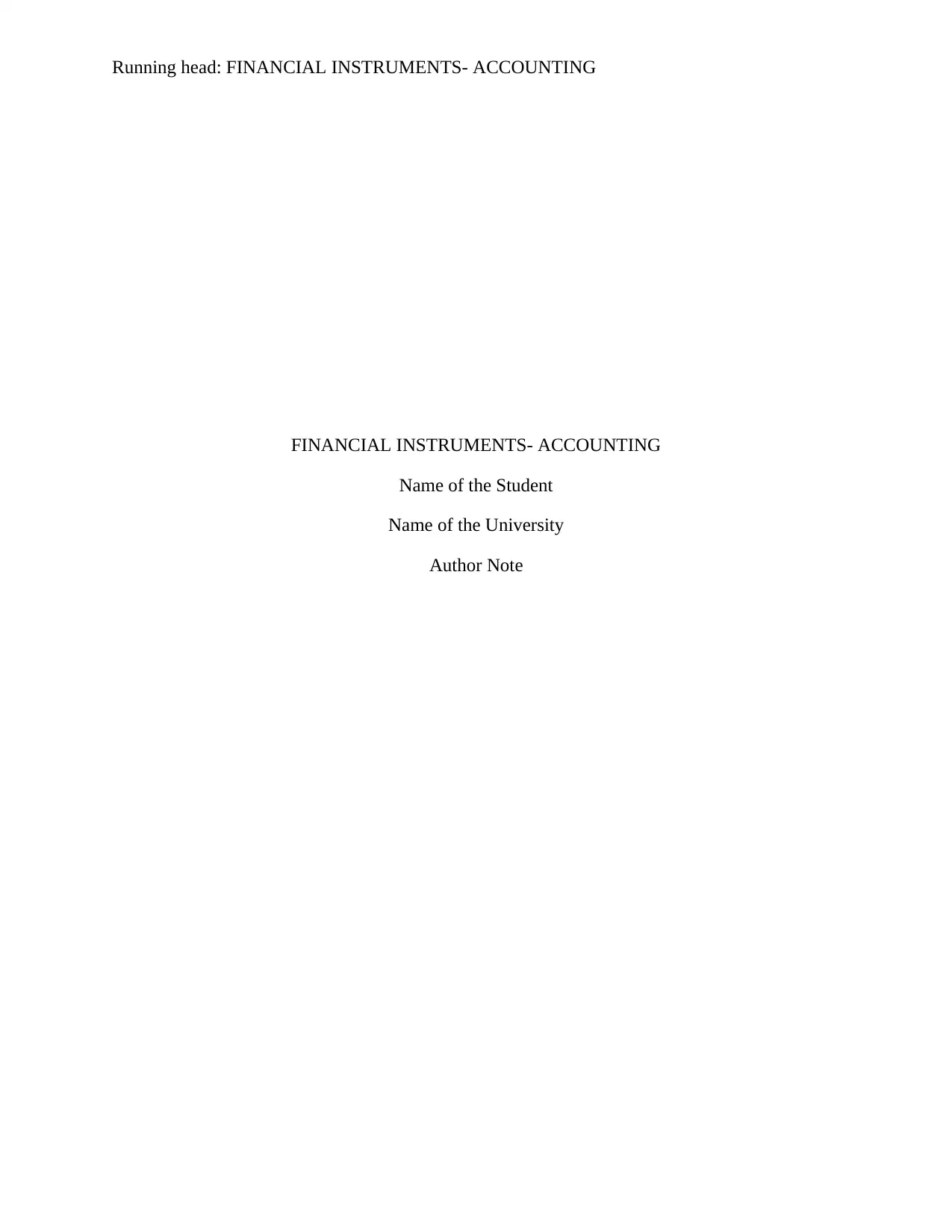
Running head: FINANCIAL INSTRUMENTS- ACCOUNTING
FINANCIAL INSTRUMENTS- ACCOUNTING
Name of the Student
Name of the University
Author Note
FINANCIAL INSTRUMENTS- ACCOUNTING
Name of the Student
Name of the University
Author Note
Paraphrase This Document
Need a fresh take? Get an instant paraphrase of this document with our AI Paraphraser
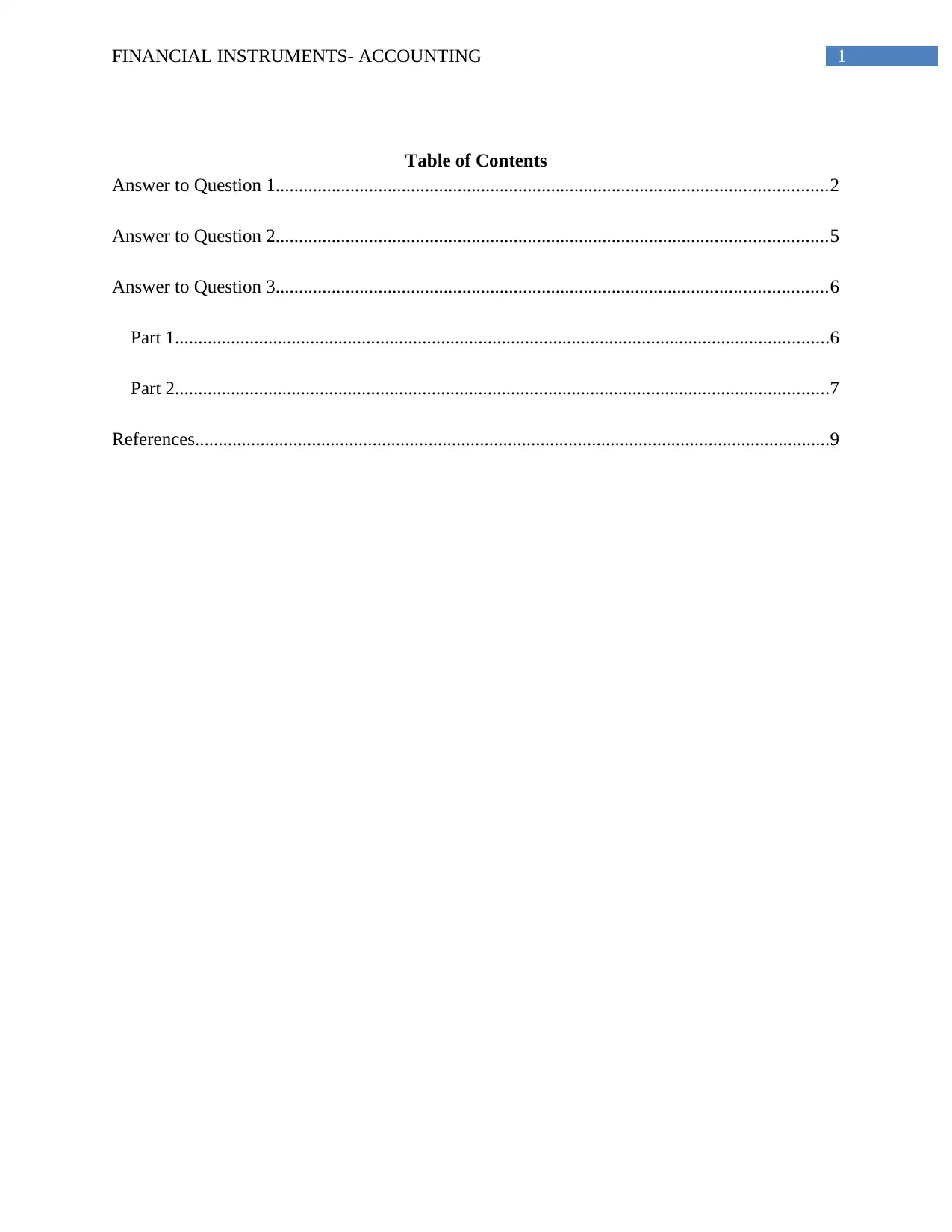
1FINANCIAL INSTRUMENTS- ACCOUNTING
Table of Contents
Answer to Question 1......................................................................................................................2
Answer to Question 2......................................................................................................................5
Answer to Question 3......................................................................................................................6
Part 1............................................................................................................................................6
Part 2............................................................................................................................................7
References........................................................................................................................................9
Table of Contents
Answer to Question 1......................................................................................................................2
Answer to Question 2......................................................................................................................5
Answer to Question 3......................................................................................................................6
Part 1............................................................................................................................................6
Part 2............................................................................................................................................7
References........................................................................................................................................9
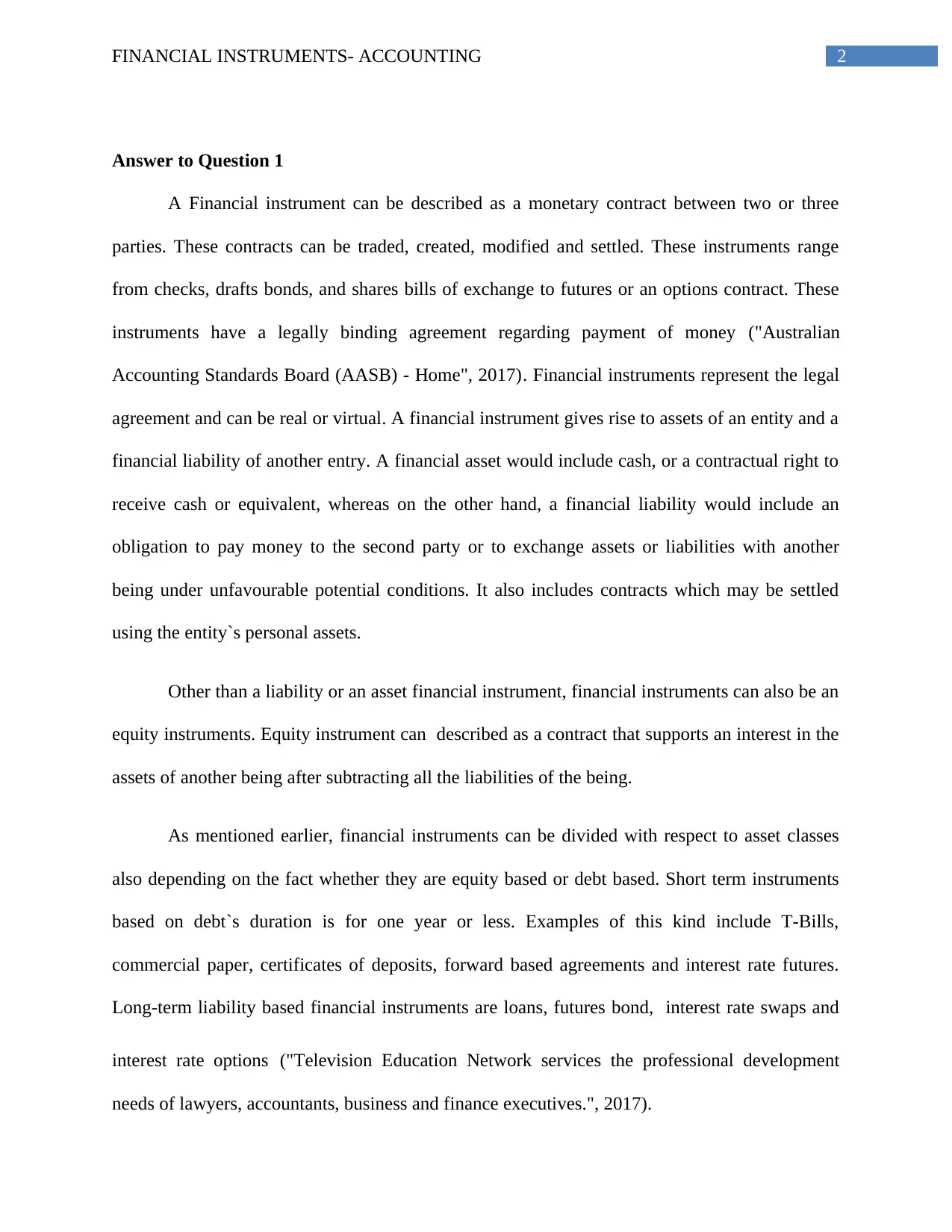
2FINANCIAL INSTRUMENTS- ACCOUNTING
Answer to Question 1
A Financial instrument can be described as a monetary contract between two or three
parties. These contracts can be traded, created, modified and settled. These instruments range
from checks, drafts bonds, and shares bills of exchange to futures or an options contract. These
instruments have a legally binding agreement regarding payment of money ("Australian
Accounting Standards Board (AASB) - Home", 2017). Financial instruments represent the legal
agreement and can be real or virtual. A financial instrument gives rise to assets of an entity and a
financial liability of another entry. A financial asset would include cash, or a contractual right to
receive cash or equivalent, whereas on the other hand, a financial liability would include an
obligation to pay money to the second party or to exchange assets or liabilities with another
being under unfavourable potential conditions. It also includes contracts which may be settled
using the entity`s personal assets.
Other than a liability or an asset financial instrument, financial instruments can also be an
equity instruments. Equity instrument can described as a contract that supports an interest in the
assets of another being after subtracting all the liabilities of the being.
As mentioned earlier, financial instruments can be divided with respect to asset classes
also depending on the fact whether they are equity based or debt based. Short term instruments
based on debt`s duration is for one year or less. Examples of this kind include T-Bills,
commercial paper, certificates of deposits, forward based agreements and interest rate futures.
Long-term liability based financial instruments are loans, futures bond, interest rate swaps and
interest rate options ("Television Education Network services the professional development
needs of lawyers, accountants, business and finance executives.", 2017).
Answer to Question 1
A Financial instrument can be described as a monetary contract between two or three
parties. These contracts can be traded, created, modified and settled. These instruments range
from checks, drafts bonds, and shares bills of exchange to futures or an options contract. These
instruments have a legally binding agreement regarding payment of money ("Australian
Accounting Standards Board (AASB) - Home", 2017). Financial instruments represent the legal
agreement and can be real or virtual. A financial instrument gives rise to assets of an entity and a
financial liability of another entry. A financial asset would include cash, or a contractual right to
receive cash or equivalent, whereas on the other hand, a financial liability would include an
obligation to pay money to the second party or to exchange assets or liabilities with another
being under unfavourable potential conditions. It also includes contracts which may be settled
using the entity`s personal assets.
Other than a liability or an asset financial instrument, financial instruments can also be an
equity instruments. Equity instrument can described as a contract that supports an interest in the
assets of another being after subtracting all the liabilities of the being.
As mentioned earlier, financial instruments can be divided with respect to asset classes
also depending on the fact whether they are equity based or debt based. Short term instruments
based on debt`s duration is for one year or less. Examples of this kind include T-Bills,
commercial paper, certificates of deposits, forward based agreements and interest rate futures.
Long-term liability based financial instruments are loans, futures bond, interest rate swaps and
interest rate options ("Television Education Network services the professional development
needs of lawyers, accountants, business and finance executives.", 2017).
⊘ This is a preview!⊘
Do you want full access?
Subscribe today to unlock all pages.

Trusted by 1+ million students worldwide
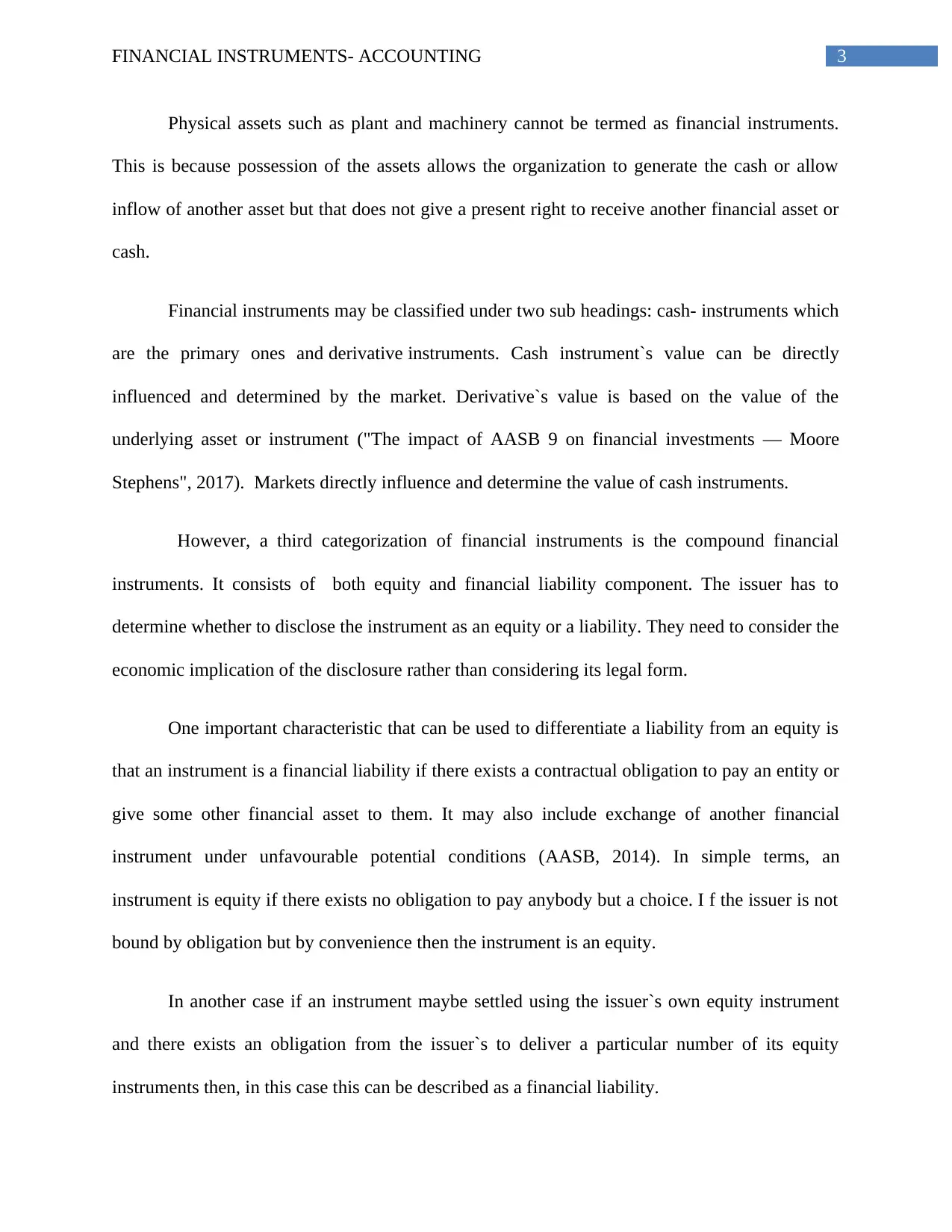
3FINANCIAL INSTRUMENTS- ACCOUNTING
Physical assets such as plant and machinery cannot be termed as financial instruments.
This is because possession of the assets allows the organization to generate the cash or allow
inflow of another asset but that does not give a present right to receive another financial asset or
cash.
Financial instruments may be classified under two sub headings: cash- instruments which
are the primary ones and derivative instruments. Cash instrument`s value can be directly
influenced and determined by the market. Derivative`s value is based on the value of the
underlying asset or instrument ("The impact of AASB 9 on financial investments — Moore
Stephens", 2017). Markets directly influence and determine the value of cash instruments.
However, a third categorization of financial instruments is the compound financial
instruments. It consists of both equity and financial liability component. The issuer has to
determine whether to disclose the instrument as an equity or a liability. They need to consider the
economic implication of the disclosure rather than considering its legal form.
One important characteristic that can be used to differentiate a liability from an equity is
that an instrument is a financial liability if there exists a contractual obligation to pay an entity or
give some other financial asset to them. It may also include exchange of another financial
instrument under unfavourable potential conditions (AASB, 2014). In simple terms, an
instrument is equity if there exists no obligation to pay anybody but a choice. I f the issuer is not
bound by obligation but by convenience then the instrument is an equity.
In another case if an instrument maybe settled using the issuer`s own equity instrument
and there exists an obligation from the issuer`s to deliver a particular number of its equity
instruments then, in this case this can be described as a financial liability.
Physical assets such as plant and machinery cannot be termed as financial instruments.
This is because possession of the assets allows the organization to generate the cash or allow
inflow of another asset but that does not give a present right to receive another financial asset or
cash.
Financial instruments may be classified under two sub headings: cash- instruments which
are the primary ones and derivative instruments. Cash instrument`s value can be directly
influenced and determined by the market. Derivative`s value is based on the value of the
underlying asset or instrument ("The impact of AASB 9 on financial investments — Moore
Stephens", 2017). Markets directly influence and determine the value of cash instruments.
However, a third categorization of financial instruments is the compound financial
instruments. It consists of both equity and financial liability component. The issuer has to
determine whether to disclose the instrument as an equity or a liability. They need to consider the
economic implication of the disclosure rather than considering its legal form.
One important characteristic that can be used to differentiate a liability from an equity is
that an instrument is a financial liability if there exists a contractual obligation to pay an entity or
give some other financial asset to them. It may also include exchange of another financial
instrument under unfavourable potential conditions (AASB, 2014). In simple terms, an
instrument is equity if there exists no obligation to pay anybody but a choice. I f the issuer is not
bound by obligation but by convenience then the instrument is an equity.
In another case if an instrument maybe settled using the issuer`s own equity instrument
and there exists an obligation from the issuer`s to deliver a particular number of its equity
instruments then, in this case this can be described as a financial liability.
Paraphrase This Document
Need a fresh take? Get an instant paraphrase of this document with our AI Paraphraser
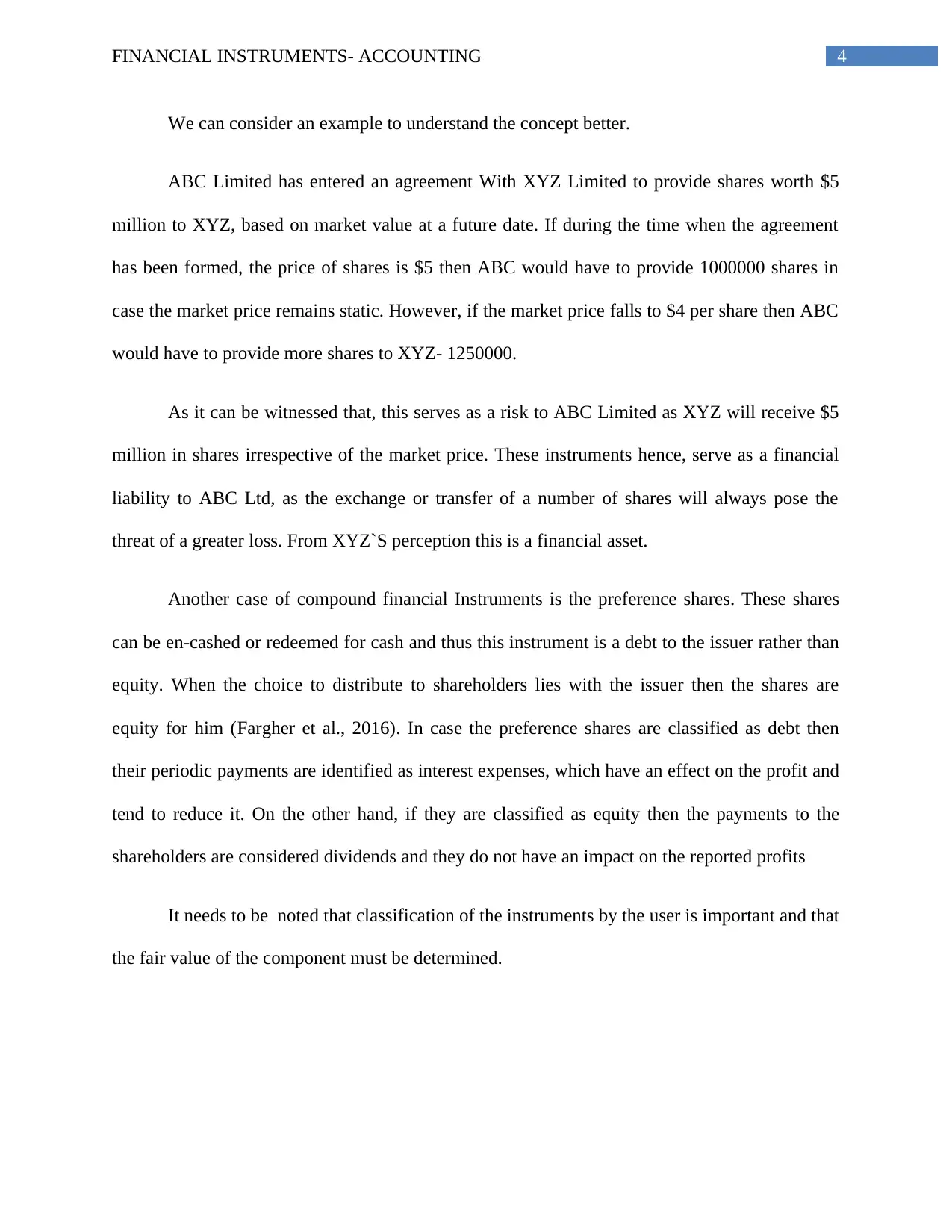
4FINANCIAL INSTRUMENTS- ACCOUNTING
We can consider an example to understand the concept better.
ABC Limited has entered an agreement With XYZ Limited to provide shares worth $5
million to XYZ, based on market value at a future date. If during the time when the agreement
has been formed, the price of shares is $5 then ABC would have to provide 1000000 shares in
case the market price remains static. However, if the market price falls to $4 per share then ABC
would have to provide more shares to XYZ- 1250000.
As it can be witnessed that, this serves as a risk to ABC Limited as XYZ will receive $5
million in shares irrespective of the market price. These instruments hence, serve as a financial
liability to ABC Ltd, as the exchange or transfer of a number of shares will always pose the
threat of a greater loss. From XYZ`S perception this is a financial asset.
Another case of compound financial Instruments is the preference shares. These shares
can be en-cashed or redeemed for cash and thus this instrument is a debt to the issuer rather than
equity. When the choice to distribute to shareholders lies with the issuer then the shares are
equity for him (Fargher et al., 2016). In case the preference shares are classified as debt then
their periodic payments are identified as interest expenses, which have an effect on the profit and
tend to reduce it. On the other hand, if they are classified as equity then the payments to the
shareholders are considered dividends and they do not have an impact on the reported profits
It needs to be noted that classification of the instruments by the user is important and that
the fair value of the component must be determined.
We can consider an example to understand the concept better.
ABC Limited has entered an agreement With XYZ Limited to provide shares worth $5
million to XYZ, based on market value at a future date. If during the time when the agreement
has been formed, the price of shares is $5 then ABC would have to provide 1000000 shares in
case the market price remains static. However, if the market price falls to $4 per share then ABC
would have to provide more shares to XYZ- 1250000.
As it can be witnessed that, this serves as a risk to ABC Limited as XYZ will receive $5
million in shares irrespective of the market price. These instruments hence, serve as a financial
liability to ABC Ltd, as the exchange or transfer of a number of shares will always pose the
threat of a greater loss. From XYZ`S perception this is a financial asset.
Another case of compound financial Instruments is the preference shares. These shares
can be en-cashed or redeemed for cash and thus this instrument is a debt to the issuer rather than
equity. When the choice to distribute to shareholders lies with the issuer then the shares are
equity for him (Fargher et al., 2016). In case the preference shares are classified as debt then
their periodic payments are identified as interest expenses, which have an effect on the profit and
tend to reduce it. On the other hand, if they are classified as equity then the payments to the
shareholders are considered dividends and they do not have an impact on the reported profits
It needs to be noted that classification of the instruments by the user is important and that
the fair value of the component must be determined.
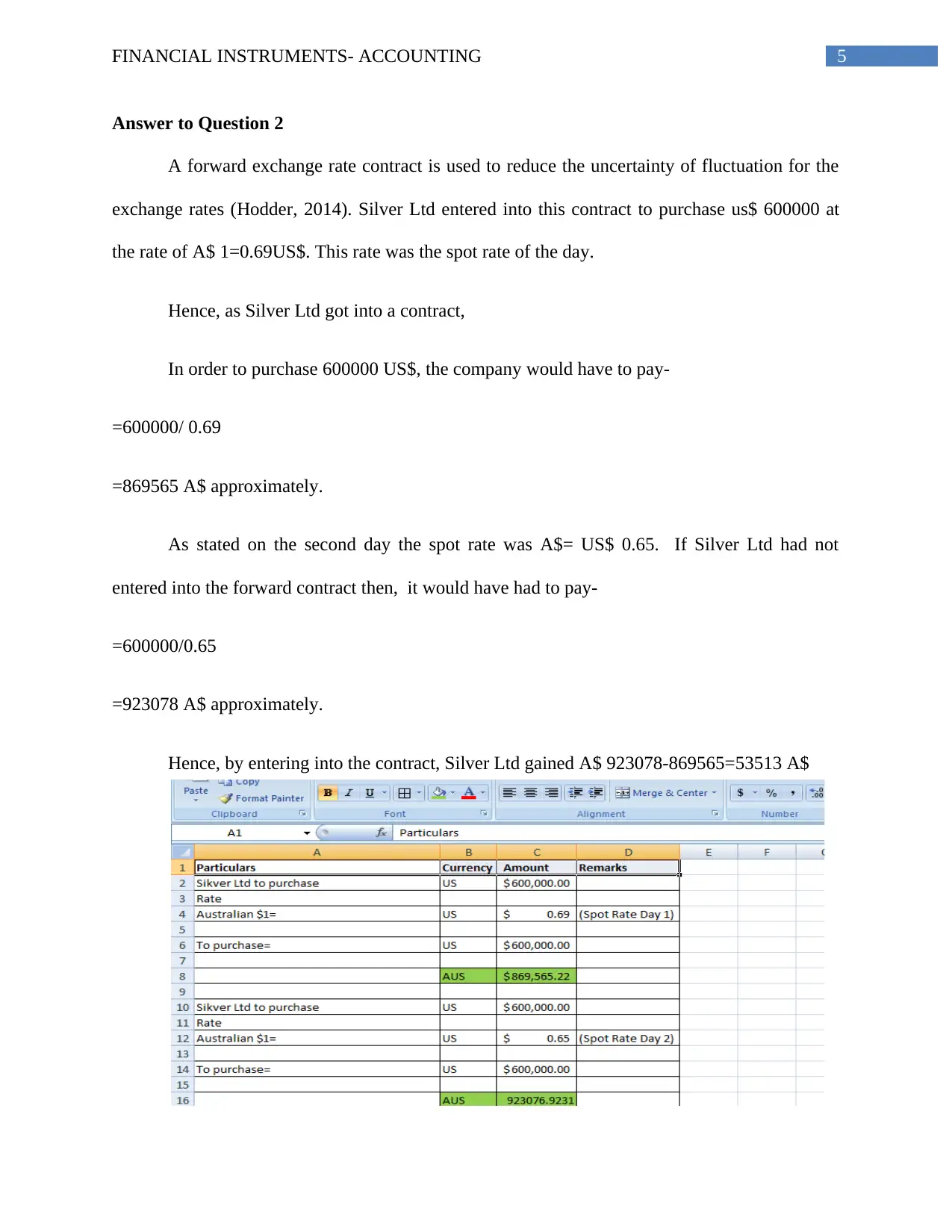
5FINANCIAL INSTRUMENTS- ACCOUNTING
Answer to Question 2
A forward exchange rate contract is used to reduce the uncertainty of fluctuation for the
exchange rates (Hodder, 2014). Silver Ltd entered into this contract to purchase us$ 600000 at
the rate of A$ 1=0.69US$. This rate was the spot rate of the day.
Hence, as Silver Ltd got into a contract,
In order to purchase 600000 US$, the company would have to pay-
=600000/ 0.69
=869565 A$ approximately.
As stated on the second day the spot rate was A$= US$ 0.65. If Silver Ltd had not
entered into the forward contract then, it would have had to pay-
=600000/0.65
=923078 A$ approximately.
Hence, by entering into the contract, Silver Ltd gained A$ 923078-869565=53513 A$
Answer to Question 2
A forward exchange rate contract is used to reduce the uncertainty of fluctuation for the
exchange rates (Hodder, 2014). Silver Ltd entered into this contract to purchase us$ 600000 at
the rate of A$ 1=0.69US$. This rate was the spot rate of the day.
Hence, as Silver Ltd got into a contract,
In order to purchase 600000 US$, the company would have to pay-
=600000/ 0.69
=869565 A$ approximately.
As stated on the second day the spot rate was A$= US$ 0.65. If Silver Ltd had not
entered into the forward contract then, it would have had to pay-
=600000/0.65
=923078 A$ approximately.
Hence, by entering into the contract, Silver Ltd gained A$ 923078-869565=53513 A$
⊘ This is a preview!⊘
Do you want full access?
Subscribe today to unlock all pages.

Trusted by 1+ million students worldwide
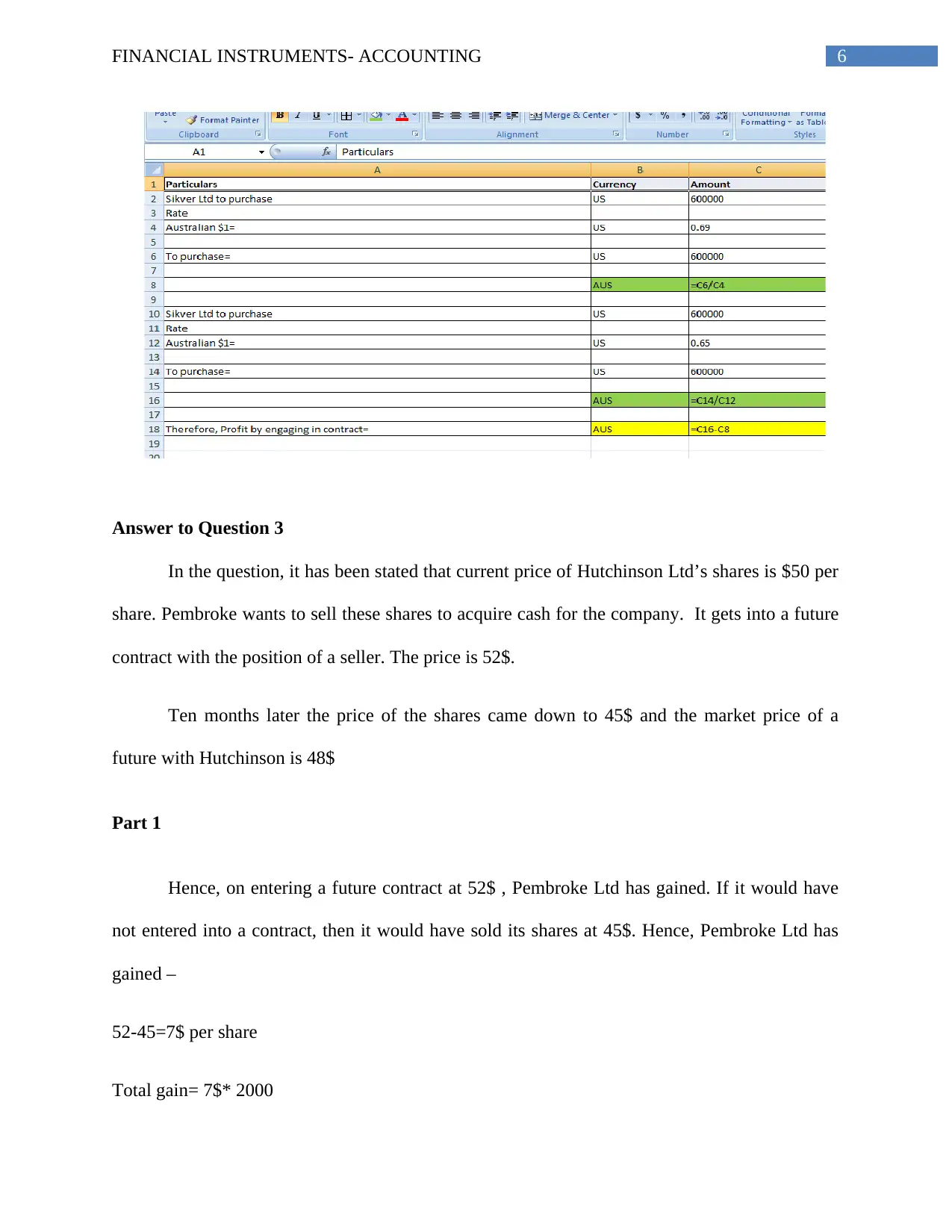
6FINANCIAL INSTRUMENTS- ACCOUNTING
Answer to Question 3
In the question, it has been stated that current price of Hutchinson Ltd’s shares is $50 per
share. Pembroke wants to sell these shares to acquire cash for the company. It gets into a future
contract with the position of a seller. The price is 52$.
Ten months later the price of the shares came down to 45$ and the market price of a
future with Hutchinson is 48$
Part 1
Hence, on entering a future contract at 52$ , Pembroke Ltd has gained. If it would have
not entered into a contract, then it would have sold its shares at 45$. Hence, Pembroke Ltd has
gained –
52-45=7$ per share
Total gain= 7$* 2000
Answer to Question 3
In the question, it has been stated that current price of Hutchinson Ltd’s shares is $50 per
share. Pembroke wants to sell these shares to acquire cash for the company. It gets into a future
contract with the position of a seller. The price is 52$.
Ten months later the price of the shares came down to 45$ and the market price of a
future with Hutchinson is 48$
Part 1
Hence, on entering a future contract at 52$ , Pembroke Ltd has gained. If it would have
not entered into a contract, then it would have sold its shares at 45$. Hence, Pembroke Ltd has
gained –
52-45=7$ per share
Total gain= 7$* 2000
Paraphrase This Document
Need a fresh take? Get an instant paraphrase of this document with our AI Paraphraser
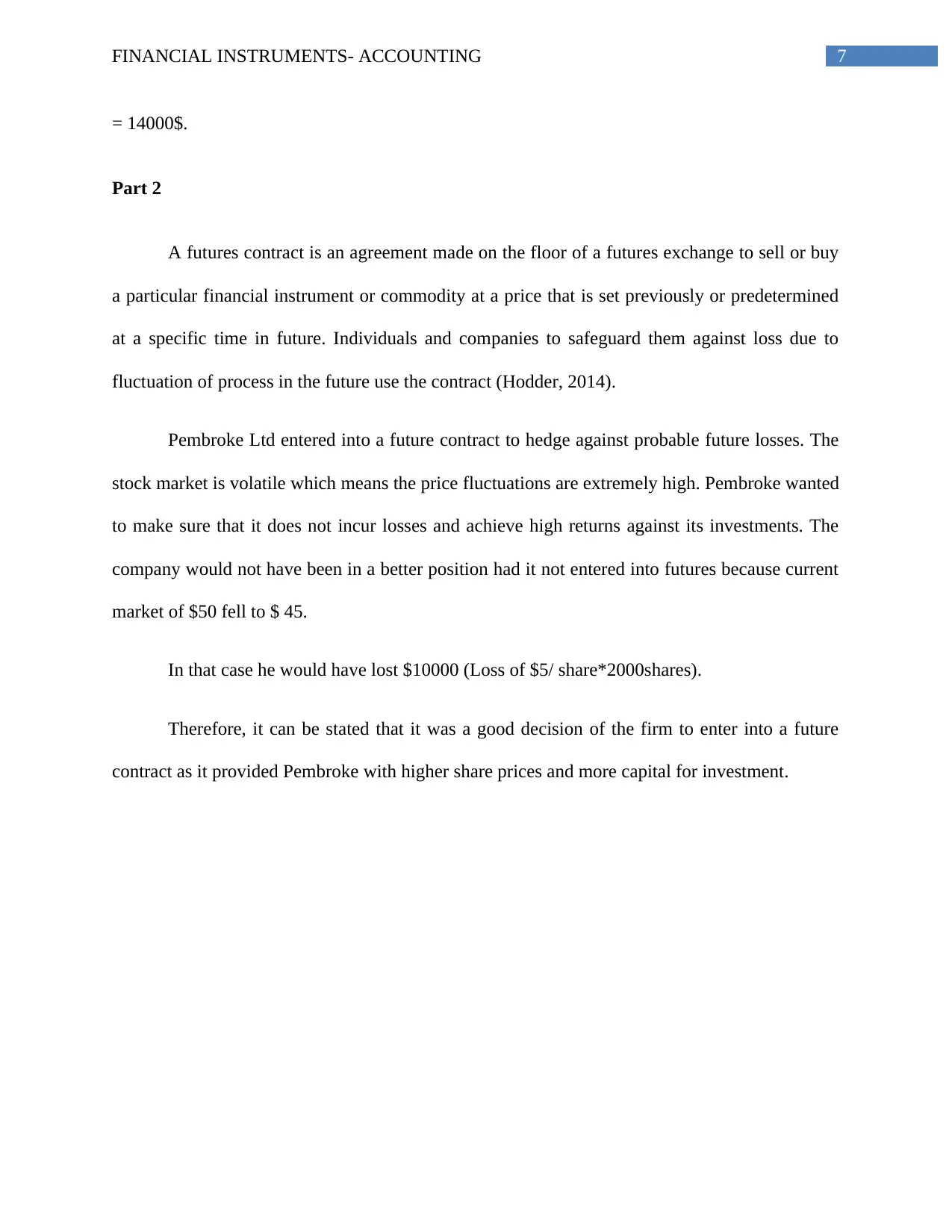
7FINANCIAL INSTRUMENTS- ACCOUNTING
= 14000$.
Part 2
A futures contract is an agreement made on the floor of a futures exchange to sell or buy
a particular financial instrument or commodity at a price that is set previously or predetermined
at a specific time in future. Individuals and companies to safeguard them against loss due to
fluctuation of process in the future use the contract (Hodder, 2014).
Pembroke Ltd entered into a future contract to hedge against probable future losses. The
stock market is volatile which means the price fluctuations are extremely high. Pembroke wanted
to make sure that it does not incur losses and achieve high returns against its investments. The
company would not have been in a better position had it not entered into futures because current
market of $50 fell to $ 45.
In that case he would have lost $10000 (Loss of $5/ share*2000shares).
Therefore, it can be stated that it was a good decision of the firm to enter into a future
contract as it provided Pembroke with higher share prices and more capital for investment.
= 14000$.
Part 2
A futures contract is an agreement made on the floor of a futures exchange to sell or buy
a particular financial instrument or commodity at a price that is set previously or predetermined
at a specific time in future. Individuals and companies to safeguard them against loss due to
fluctuation of process in the future use the contract (Hodder, 2014).
Pembroke Ltd entered into a future contract to hedge against probable future losses. The
stock market is volatile which means the price fluctuations are extremely high. Pembroke wanted
to make sure that it does not incur losses and achieve high returns against its investments. The
company would not have been in a better position had it not entered into futures because current
market of $50 fell to $ 45.
In that case he would have lost $10000 (Loss of $5/ share*2000shares).
Therefore, it can be stated that it was a good decision of the firm to enter into a future
contract as it provided Pembroke with higher share prices and more capital for investment.
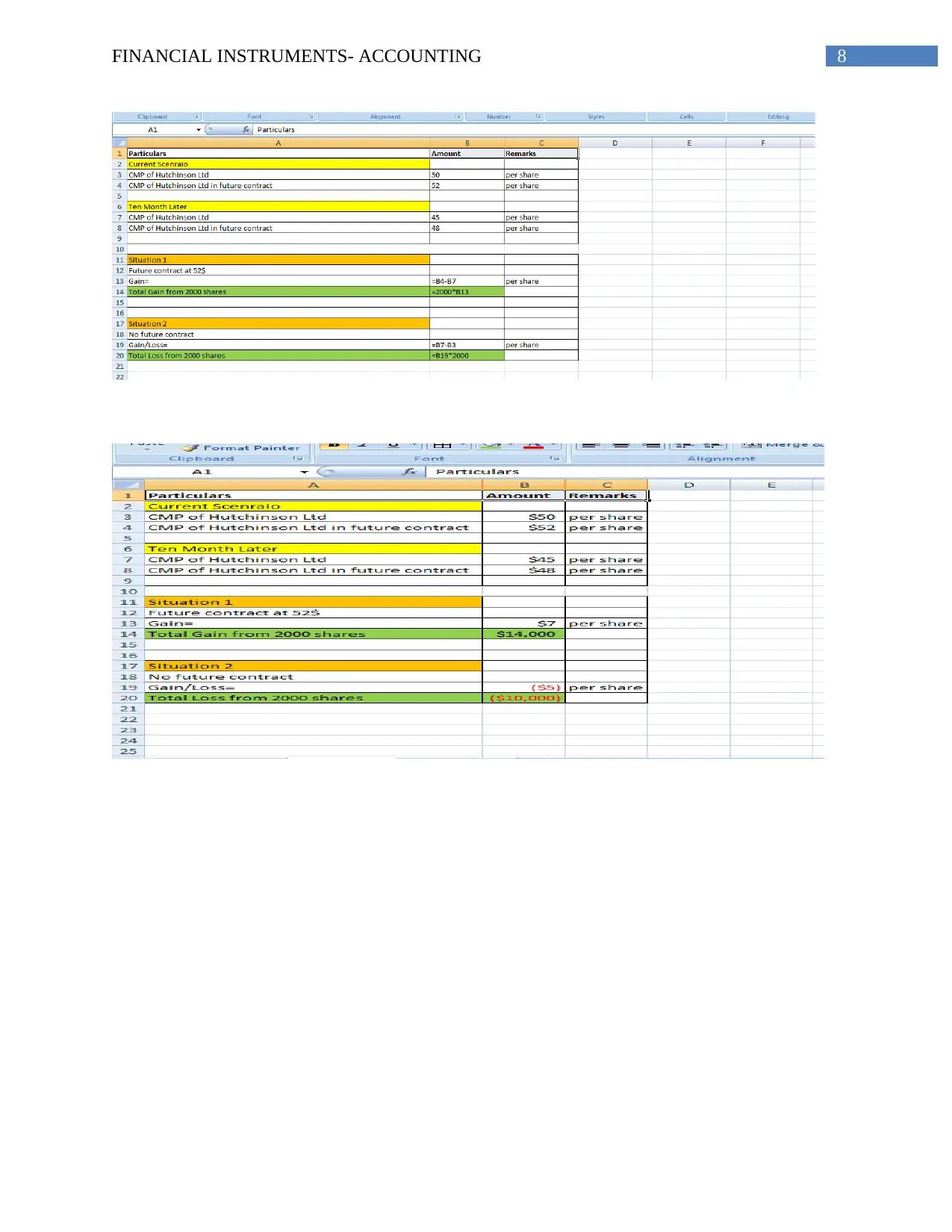
8FINANCIAL INSTRUMENTS- ACCOUNTING
⊘ This is a preview!⊘
Do you want full access?
Subscribe today to unlock all pages.

Trusted by 1+ million students worldwide
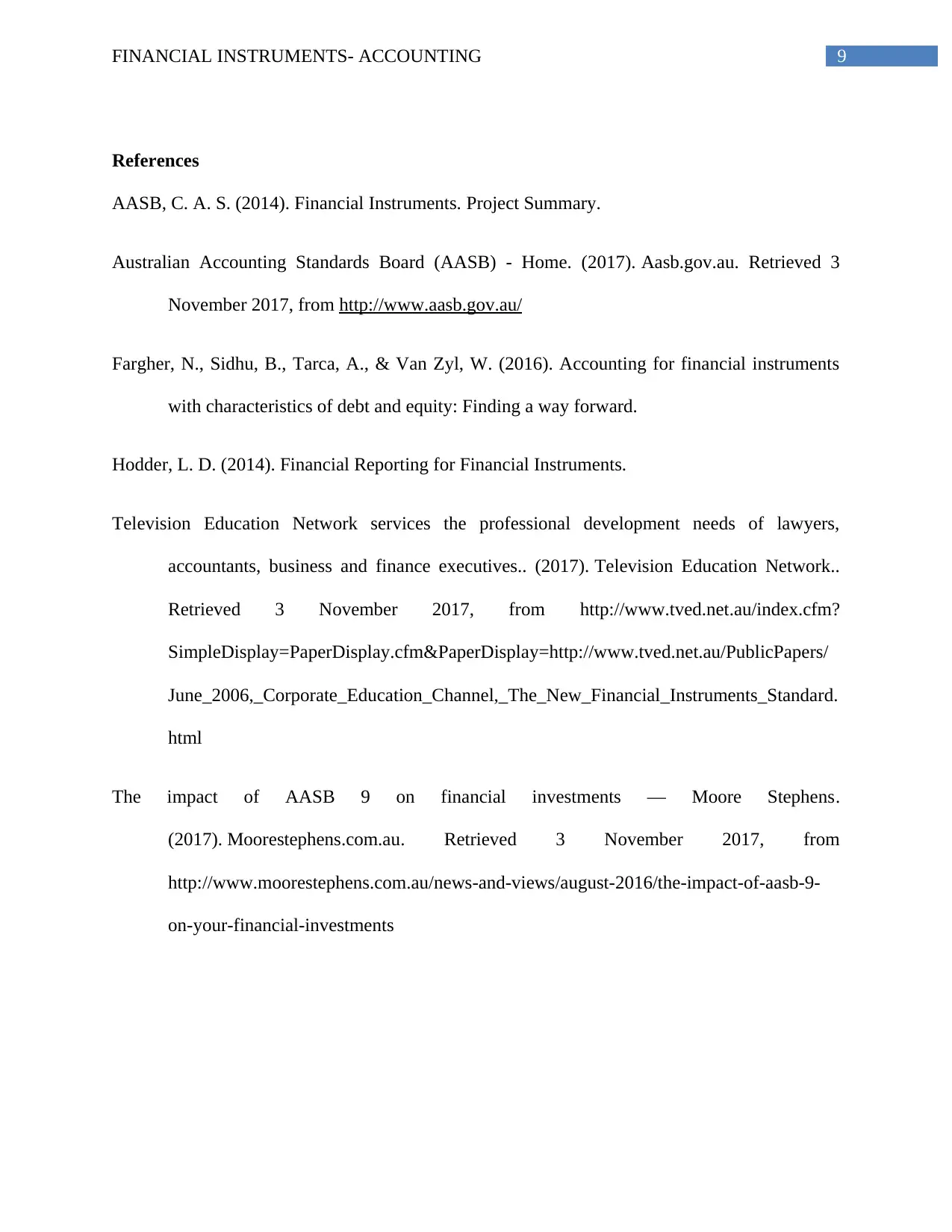
9FINANCIAL INSTRUMENTS- ACCOUNTING
References
AASB, C. A. S. (2014). Financial Instruments. Project Summary.
Australian Accounting Standards Board (AASB) - Home. (2017). Aasb.gov.au. Retrieved 3
November 2017, from http://www.aasb.gov.au/
Fargher, N., Sidhu, B., Tarca, A., & Van Zyl, W. (2016). Accounting for financial instruments
with characteristics of debt and equity: Finding a way forward.
Hodder, L. D. (2014). Financial Reporting for Financial Instruments.
Television Education Network services the professional development needs of lawyers,
accountants, business and finance executives.. (2017). Television Education Network..
Retrieved 3 November 2017, from http://www.tved.net.au/index.cfm?
SimpleDisplay=PaperDisplay.cfm&PaperDisplay=http://www.tved.net.au/PublicPapers/
June_2006,_Corporate_Education_Channel,_The_New_Financial_Instruments_Standard.
html
The impact of AASB 9 on financial investments — Moore Stephens.
(2017). Moorestephens.com.au. Retrieved 3 November 2017, from
http://www.moorestephens.com.au/news-and-views/august-2016/the-impact-of-aasb-9-
on-your-financial-investments
References
AASB, C. A. S. (2014). Financial Instruments. Project Summary.
Australian Accounting Standards Board (AASB) - Home. (2017). Aasb.gov.au. Retrieved 3
November 2017, from http://www.aasb.gov.au/
Fargher, N., Sidhu, B., Tarca, A., & Van Zyl, W. (2016). Accounting for financial instruments
with characteristics of debt and equity: Finding a way forward.
Hodder, L. D. (2014). Financial Reporting for Financial Instruments.
Television Education Network services the professional development needs of lawyers,
accountants, business and finance executives.. (2017). Television Education Network..
Retrieved 3 November 2017, from http://www.tved.net.au/index.cfm?
SimpleDisplay=PaperDisplay.cfm&PaperDisplay=http://www.tved.net.au/PublicPapers/
June_2006,_Corporate_Education_Channel,_The_New_Financial_Instruments_Standard.
html
The impact of AASB 9 on financial investments — Moore Stephens.
(2017). Moorestephens.com.au. Retrieved 3 November 2017, from
http://www.moorestephens.com.au/news-and-views/august-2016/the-impact-of-aasb-9-
on-your-financial-investments
1 out of 10
Related Documents
Your All-in-One AI-Powered Toolkit for Academic Success.
+13062052269
info@desklib.com
Available 24*7 on WhatsApp / Email
![[object Object]](/_next/static/media/star-bottom.7253800d.svg)
Unlock your academic potential
Copyright © 2020–2025 A2Z Services. All Rights Reserved. Developed and managed by ZUCOL.




